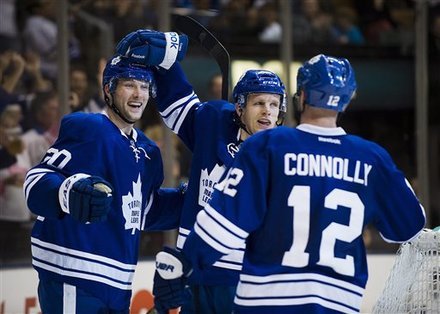
Remember Alex Steen?
The Leafs drafted him in the first round in 2002, 24th overall. He cracked the NHL in 2005, in part due to the lockout that occurred the year before. Regardless, he played alongside Mats Sundin and had a relatively successful rookie season scoring 18 goals and 45 points. The following season he regressed statistically, notching 15 goals and 35 points.
In that leap from year one, to year two, everyone expected Steen to take “the next step” in his development and grow his point totals playing on Sundin’s wing for a second straight year. Unfortunately for the Leafs and Steen, that didn’t happen. Alex struggled to rediscover his scoring touch, increased expectations mounted on him, and it basically wasn’t the year everyone expected from him.
The year after that, Steen scored 15 goals yet again, but bumped his point totals up to 42 points. By that point, the general consensus around town was that he was a “tweener” player. Not really a top six forward, not really a grinder, but still a solid two-way hockey player.
Then he started his time under Ron Wilson by putting up four points in 20 games, despite the fact that Ron Wilson began the season playing him on line one. After game 20 he was traded to the St. Louis Blues and the feeling among fans and media alike was the fact that the Leafs “blew” another first round pick. Not that they gave up on him too early.
He supported that theory by posting a mediocre six goals and 24 points in his remaining 61 games as a Blue that season.
But the next season, a funny thing began to happen. Alex Steen began to put it together. At age 25.
That would be the 2009-2010 season, the first season he cracked the 20 goal barrier, notching 24. He also had a career high 47 points, in a career low 68 games. In 2010-201, Steen hit the 20 goal plateau again, and topped his career high yet again, with 51 points.
This season, Steen has battled a serious concussion, but his 24 points in 36 games would have had him on pace for 54 points, yet another career high.
So what’s the moral of the story here? To rub in the fact that the Leafs gave up a pretty darn good hockey player for Lee Stempniak? To remind everyone that had the Leafs not given up on Steen before he even remotely hit the prime age that more or less all men fully develop at, they would have had an excellent two-way line in Steen-Grabovski-Kulemin? To point out that had Steen not been hurt this season and kept up the pace he was producing at, that he would probably have finished third on this current Toronto team in points?
No. That really isn’t the moral of the story.
The moral is that some players take a long time to develop. Alex Steen just turned 27 this month. He’s finally figured out his role, his niche in the league, and he’s been thriving in it the last few years.
So in summary: He was drafted in 2002 at 18. At 21, in 2005, he began his NHL career. He was traded at 24. He started thriving at 26. This current draft will mark 10 years since he’s been drafted.
That’s how long it took him.
And fans are wondering why Kadri isn’t “ready,” why Colborne isn’t tearing up the AHL, and so on.
Players all grow at different times. I’m not sitting here and saying Kadri, Colborne, Ashton and the gang are all going to mirror Steen’s development, but I am saying it’s nowhere near time to give up on these guys. Generally speaking, we really find out about most players around age 26 or 27. Obviously there are exceptions to that, but it’s pretty obvious in those scenarios.
Brian Burke is taking a lot of heat right now, but something that’s not being brought up right now is this: while the NHL roster is lacking right now, however, the rest of the organization has been growing nicely.
Without even looking at the prospects he’s brought in -which we quickly will in a second – let’s see who Brian Burke has brought in to the organization. You know the group by now, Dave Poulin, Dave Nonis, Claude Loiselle (sidebar: Loiselle was GM of the Norfolk Admirals, meaning Matt Lashoff’s acquisition was his doing), Rick Dudley, Dallas Eakins, etc.
There’s no point in going over the pedigree of all those guys because it’s been beaten to death at this point. What hasn’t though, is when you do these things right, when you honour the process of drafting players, taking your time developing them, creating positive atmospheres led by excellent coaches and management throughout your organization, that it’s bound to pay off.
It’s like anything, when you build something properly by following a well laid out process, it eventually pays dividends. Now the Leafs are about to add a very high first round pick to this group. Again, the NHL roster has a ton of issues, but you have to look past the trees, and see the forest. There are positive things happening throughout the rest of the organization.
When you go through some of the players in the Leafs system, there should be a lot to be excited about.
As was pointed out on Coach’s Corner, Nazem Kadri has abilities you can’t teach. His vision, hands, flare for the dramatic, you can’t coach those things. A player either has them or he doesn’t. Yes, his skating needs a little work, he needs to work on conditioning more, and his defensive game lacks polish. But those are all easily coachable. And he’s 21.
You could also look at a guy like Jerry D’Amigo, whose skating is already top notch. Last season he couldn’t handle the full grind of the AHL season. This year? He’s a key contributor on one of the best teams in the league. He just turned 21.
Even a guy like Tyler Bozak. When he was signed by Toronto, everyone knew he was a “classic late bloomer.” His first year with the organization, he was playing well with the Marlies then got hit by H1N1, then came back and he played fantastic with the Leafs when he was finally called up. Then they thought he could center the number one line for the next year, he struggled, the pressure mounted and it wasn’t a great year. This season, though, he turned around and has put up 43 points. He still has room to grow, he’s 26, but he’s only been in the league for three years.
The examples can go on for awhile, so I’ll cut it there. Overall though, there are good things happening within the organization, and they aren’t getting recognized enough.
Yes, Burke said he didn’t want a five year rebuild, and he said he underestimated how bad this team truly is, but he was never a fool. The proof you really need is in this interview with Norman James, three months into his job as GM here. Burke always talked about building a franchise that was successful for the long haul. How do you do that? You build with youth. If there’s one thing even the NHL team is, it’s young.
Too often, like with Steen, everyone looks at the Leafs prospects and expects all stars and saviours. I don’t know where the idea of any NHL team requiring a saviour to turn their fortunes around came from, but it needs to stop.
This isn’t basketball.
Heck, Crosby was helped by Malkin, Fleury and Letang; Toews was helped by Sharp, Hossa and Kane, and so on. There’s never just one saviour. It has to be a core of very good players.
NHL teams need a multitude of different pieces and assets to win. The mantra in the organization has to be developing quality NHL players consistently. The rest will take care of itself after that naturally. But in five years if we’re looking at guys like Ashton, Kadri, Colborne, D’Amigo, Biggs, Blacker, Holzer, Percy and so on all in Leaf jerseys, then the process paid off. If they aren’t? Then it went wrong. Either way, we won’t know for years to come what all these kids truly are, because they are all so far away from their physical primes as men. That’s not to say the Leafs have to hopelessly wait for these guys to be ready – I’ll have an article on the next steps soon – but it is to say there is good long term building taking place.
And there’s one thing we do know: It’s not time to give up on anyone, unless you’re getting an equally young player back.
(See: Aulie for Ashton).
***
Obviously, I missed Leafs Notebook last week. For this weeks, I did include numerous notes that would have went in last weeks. In other words, there may be a lot to read still.
– Gained a lot of respect for Mikhail Grabovski for standing up to Chris Neil and protecting a teammate the way he did. Chris Neil is a lot of things, but a bad fighter isn’t one of them. The outcome of the fight was never what mattered, it was the principle of the matter. An experienced fighter is not allowed to pick on a young guy whose playing in his sixth NHL game ever. Grabovski has always shown that he cares and that he’s willing to take a hit, but he’s never really shown that he’ll put his body on the line in a fight, so to do so while sticking up for a teammate was admirable.
– Seeing Grabovski stick up for Ashton made me think of Luke Schenn in his rookie season. If you’ll recall, there were numerous times where he had to stick up for himself, or even other teammates, because nobody else was answering the bell. Here’s an 18 year old kid who nobody even expected to make the team, and he has to fight his own battles and others battles without any help. It’s nice to see the more seasoned Leaf players doing what Grabovski did, but you do wish Schenn was nurtured in that kind of environment.
– I’ve said for awhile now that from day one of his career, Schenn needed a true, grizzled, defense partner to teach him the ropes of playing a shutdown role in the NHL and to keep his play, and mental game, in line. Basically, he needed a real mentor. It’s been four years and he still hasn’t had one.
– Some articles have come out over the last week that have really made Ron Wilson a scapegoat for Luke Schenn’s poor season, but I’m not buying it. The first thing to note is that Schenn had two very good seasons under Wilson, so it’s not as if he never had success under Ron’s regime, and that the coach just completely crushed him from day one. The second is that Schenn has been bad since his first preseason game. I gave him the benefit of the doubt in preseason because it’s only preseason, but even when the games started counting, he was still playing bad. So right from the get-go, he’s been bad. That’s on him. Perhaps Wilson didn’t provide a pillar of stability and positive encouragement for Luke to emerge out of his funk, but regardless, it’s not Wilson’s fault that Schenn didn’t come to camp prepared. That’s completely on Luke. I’m sure Wilson did have problems with Schenn and that they didn’t see eye-to-eye at points this season, but there’s no way anyone should simply pinpoint a fourth year player’s bad season simply on the coach. What would you say the breakdown is? I’d say it’s at least 70% Schenn’s fault, leaving 30% to Wilson. And I stress at least.
– It’s not as if Carlyle’s positive attitude has had any sort of tangible impact on Schenn yet, by the way. He has yet to play even 17 minutes in a game for Randy yet. And he’s coached 12 games here. In Wilson’s last 12 games coaching here, Schenn surpassed the highest TOI he’s received under Carlyle (16:24), three times. When he was playing well, Wilson played him. And the Leafs were actually in a playoff chase at that point. And now they have more or less nothing to play for except proving themselves to the new coach. Yet he’s still not getting ice time, which says a lot.
– There was one play against New Jersey that I found interesting in Schenn’s game, and it was a thundering hit he had on Jacob Josefson. Both players were in a footrace for the puck around center ice near the Devils bench, Schenn got there first and knocked the puck in deep, then he hammered Josefson. I can’t recall a time that Schenn’s played the puck himself, and then looked to physically abuse the player closest to him. That’s the kind of snarl that Carlyle is going to want from him moving forward. He has to bring it consistently though.
– At the end of the day, this really is just a bad season for Schenn. He needs to turn on the reset button this summer, forget about it, work hard in the off season and come back motivated. He’s done it already in his career year, there’s no reason he can’t do it again.
– One thing that will be interesting to see if Carlyle can rectify over time is the team’s puck management. Puck management is so crucial, but often so underrated, much like faceoffs being overlooked. It’s just little things with the Leafs that are so easy to avoid, yet there are so many consistent examples of simply mismanaging the puck and turning over possession. Things like on a power play against Tampa Bay, Phil Kessel skates over the blue line, a forward approaches him, and he tries to thread it through the players legs to a streaking player. The pass never got through. Or against Florida, Tim Connolly won a draw cleanly to Mikhail Grabovski, who stood still, waited for everyone start moving up, and then, still standing still, he tried to force a pass up ice that went nowhere fast. Every team is going to give the puck away, that’s part of the game, but you don’t want to give the puck away easily. Make the other team work for it. Those are just two tiny examples of the Leafs just losing possession of the puck much too easily. Especially at this time of the year.
– The Boston massacre might be the best example on the whole. Look at Boston’s first five goals: first goal, Schenn gets a D-to-D pass, has time to make a clean breakout pass, except he doesn’t, it gets intercepted, Chris Kelly scores. The second goal, Liles and Reimer both think it’s on back of the net, but it’s in the back of the net after Gregory Campbell’s wraparound. Third goal, they don’t handle the forecheck properly, Boston works it back to the point, shot, tip, goal. Fourth goal, Marchand and Phaneuf are the only two players in front of the Leafs net, Dion doesn’t cover him, goal. The fifth goal, Gustavsson mishandles the puck behind the net, centered in front to an open net, goal.
– Nobody is doubting Boston is a far superior team to the Leafs, but Toronto handed it to them on a platter. They didn’t even make them work for it. Those were more or less all easily avoidable goals. A lot of it just comes down to simple puck management and mental mistakes. The Leafs shoot themselves in the foot more than other teams come in and just simply beat them. They really just make it easy for other teams when they are doing that.
– Some other examples of low percentage puck plays:
– Against New Jersey in OT, Dave Steckel gets put on strictly to win a faceoff in the defensive zone with Mikhail Grabovski, he wins the draw and heads immediately to the bench, as he’s doing that Carl Gunnarsson tries to hit a streaking Grabovski for a potential breakaway right up the middle by throwing a pass that would have to get through a forward and split the defense. The pass didn’t get through and the Devils turned the play quickly up ice and had a great scoring opportunity, especially since Steckel was changing which made it a 4 on 3 for a second. Now, how many times is Carl Gunnarsson of all players going to thread a pass through three guys with a perfect pass up the middle? Can he? Maybe. But the chances of it happening, especially in overtime? Terribly low. At the very least, allow Steckel to change and get the proper amount of guys out there. That’s an easy giveaway.
– Or against Boston, Phaneuf came out of the corner with the puck in his own end, and then saw Carl Gunnarsson in the other corner, but Tyler Seguin was skating to cut it off so he tried a backhand, flipped up, saucer passer to try and get it through. Seguin of course knocked it down and created a scoring chance. Out of 100 times, how many times is that pass actually going to get through an NHL player, let alone one as talented as Tyler Seguin? Not many. It’s just another low percentage puck play that needs to be corrected.
– There’s too much living and dying by the sword basically. Going for the goal instead of simply moving up ice precisely and with strong puck movement.
– While Carlyle will demand much more north-south play (meaning simply dump the puck in and go get yourself, and cycle, or skate it in if possible, instead of trying to make something out of nothing like the Leafs had been doing for much of the year). A lot of this improvement will come out of these players maturing and growing as individuals. Detroit is much too easy of an example to point out when it comes to puck management, but if you look at a team like Phoenix, how much talent do they have? I wouldn’t say more than the Leafs (maybe equal, but definitely not more), but they are a veteran team, who makes the opposition work for it. They don’t give anything away. The bottom line is that giveaways are going to happen, they are inevitable, but don’t gift wrap them. There needs to be more high-percentage passing that naturally opens up the play, instead of forcing the issue.
– A great example of the improvement in this department was Joey Crabb’s goal against the Tampa Bay Lightning. Gunnarsson goes D-to-D to his partner Phaneuf, who throws a hard pass up the boards to Tim Connolly (not soft, not unsure, but direct and hard), Lombardi cuts across the ice with his speed, takes the puck low and then finds a trailing Joey Crabb for a one timer. The Leafs score and all five players on the ice touched the puck without any of them doing anything extraordinary on the play. How many goals have the Leafs scored this year where all five players have touched the puck like that and they’ve moved up the ice that easily? Not enough. Especially with all the talent they possess on this roster.
– One thing I’d like to personally see the Leafs incorporate into their game more is changing the lines during play, with the puck on their own stick. Teams that control the play will have their defensemen stand behind the net, or pass it back and forth as the forward units change. It’s the tiniest of things, but why work hard to get the puck, just to cross center ice, dump it down deep and then change the lines? You’re just giving the opposition the puck back and allowing them to re-group, gain speed and try to score on you again.
– On that note, when people say “why don’t the Leafs trap,” this is one of the reasons. Trap teams are smart with the puck and patient. Which are two things the Leafs struggle to do consistently.
– Thought Reimer’s performance against Tampa Bay was an excellent reminder of the high level of goaltending you need to win games in this league – and that wasn’t even a solid playoff team that he played like that against. Reimer made four or five high-end saves over the course of the game and played really well. Lately I’ve read a lot of people saying, “if the Leafs just had average goaltending, they would be in the playoffs.” Well, Curtis Sanford has a 2.60GAA and .911sv%, does that mean if he was the Leafs goalie that they would make the playoffs? Come on. Teams that make the playoffs get really good goaltending. Period. (Unless you’re Philadelphia, but even then, Bryzgalov has turned it around in the last few weeks).
– Reimer’s performance against New Jersey is of course, another example.
– I like save percentage as a stat and all, but it’s not religion when it comes to goaltending. Goaltending is as much about consistency as it is about timing. Timing within a game to make a big momentum shifting save, or timing to keep your team in a game, or timing to even steal a game for your team when need be. Save percentage doesn’t reflect that, every shot is measured the same. I’m not saying it’s not a nice indicator of value, but I am saying that the Leafs goaltending is far from needing to “only” move up a few points on the save percentage grading system.
– There was one save that for some reason caught my eye and made me think Reimer was looking comfortable again. Eric Brewer broke through the defense and was behind the net with the puck and he quickly skated to the far side of the post to try a wrap around and Reimer calmly slid over to the post, got his pad out and stopped it easily. It was a far cry from his positioning on the wrap-around goal he allowed against the Washington Capitals a few weeks back not even a minute into the game.
– In the grand scheme of things Mike Komisarek’s blunder at the end of the Tampa Bay game that cost James Reimer a shutout isn’t a huge deal, but that’s something that will stick in the coaches mind the next time there’s even a remotely tight game happening. You simply can’t make that play, especially when you’re killing a penalty and are actually able to ice it without reprehension.
– A lot has been made of Dave Steckel’s ice time, and that whole third line in general. It’s an aberration. Look at Steckel’s ice time under Carlyle for the first few games, in order: 15:08, 14:37, 6:42, 14:14, 11:27, 13:51. Then his ice time began to escalate upwards. What happened to cause that to occur? Joffrey Lupul, then Nikolai Kulemin, got hurt. That last ice time I just showed – 13:51 – was from the Florida game, which is Kulemin’s last game of the season. Since then, Steckel’s played 17:29, 19:21, 14:57 (Boston game), 19:11, 22:51, 18:53. The Florida game saw Clarke MacArthur move up to the top line with Bozak and Kessel before he got hurt, and it began a streak for Grabovski of playing with rookies such as Carter Ashton, Matt Frattin, Nazem Kadri and Ryan Hamilton, who have all been playing with him since. So really, to me, it seems to be the roster dictating the lineup and game-plan because the Leafs have had some significant injuries and there’s no way Carlyle really knows what’s in the system right now, so he’s putting the young guys with a strong two-way player in Grabovski.
– Thus, in the long run, Grabovski is still the two-way center they want him to be that competes against the other teams best players nightly. As I’ve said, Steckel can’t play against the Giroux’s, Malkin’s and so on’s of the world consistently. He’s simply not fast enough.
– It makes more sense to give all those young players I just mentioned a chance to play offensively with Grabovski, then to make Connolly-Grabovski-Crabb the checking line and play guys like Kadri and Frattin with Steckel.
– One player who deserves some credit is Tim Connolly. Since Carlyle has come aboard, he’s actually averaged 18:03 a night. He’s been a net presence on the power play, he’s played on checking lines, and he’s played on the wing even though literally none of those things are areas he excels at. But is he battling. He’s also been the teams best penalty killer of all the forwards.
– I said at the beginning of the year he has the best defensive awareness on the team and I stand by that. Think about it, not only is he playing on a checking line – something he probably doesn’t want to do – but he’s not even playing center, and on top of it all, he’s not even playing on his proper wing. Yet he’s still doing well defensively. The problem with Connolly as a checker is that he’s not physical at all, and he doesn’t appear committed enough to actually play strong defense throughout an 82 game season. To be a good defensive player you have to really love the challenge of shutting down the other teams best players nightly and take it personally. Connolly appears to be more of a guy who has talent and wants to score. Square hole, round peg, basically.
– Joey Crabb on the other hand, is a little more interesting. He’s shown in spurts this season that he can get hot, and be a contributor all over the ice. Crabb also appears to be growing on Carlyle, who has spoken highly of the 28 year old (soon to be 29). The problem is that he’ll go on streaks of five or more games, where you really don’t notice him and he’s not making an impact.
– Earlier in the season Crabb scored this goal against Minnesota where he was able to drive the net hard like a power forward. Against New Jersey Tim Connolly sprung him on a partial break of sorts and Adam Larsson caught up to close the gap, and it was really disappointing to see Crabb let up on the play and try some sort of spin pass that went to nobody. Now driving Larsson is a lot different than driving Jarred Spurgeon, who is only 5’9, but you want to see grinders go to the net and make life miserable in that area. Plus, as shown, he does have some ability to make that kind of move. Also, driving the net makes things happen. Later that game, Crabb himself drove the net hard and that led to this goal by Steckel. Perhaps someone on the bench talked to him about that after the Larsson let down.
– Speaking of coaches talking to players on the bench. Phaneuf almost got into a fight with David Clarkson with a minute left in regulation against the Devils, and new Leafs assistant coach, Dave Farrish, who is leading the defense, raced down the bench to make sure Phaneuf didn’t engage. We don’t usually see coaches do that at the NHL level, so I thought it was kind of neat. Shows how tuned into the game he and Carlyle are. They are consistently talking to the players on the bench.
– Against the Rangers the Leafs strung together a few power plays in a row but couldn’t muster a thing. Carlyle called a timeout in the middle of one of them and still stayed with the Bozak-Grabovski-Kessel trio with Liles and Phaneuf on the point. The power play before, when Kadri got out there with Connolly, they started to work it around nicely and make some things happen. Was hoping to see them get more of a chance instead of continuing on with a group that wasn’t producing anything of quality.
– On the note of Kadri, there really isn’t much to say. He played two games. We’ve seen him start hot a few times now so I really wasn’t planning to actually say anything about him because again, it’s two games. But now that he’s already been sent down, it ties my hands.
– One thing I did want to point out was against New Jersey he received a drop pass in the first period and had ample time to shoot the puck by NHL standards, but in the AHL, it would have been even more time. He took so long that the shot got blocked by the time he released it. This is important to note for my point because a few weeks earlier I was watching a Marlies game that Kadri scored in, and in it he took a drop pass, made a little deke around the defenseman, and then scored. I remember wondering to myself as I watched that goal whether or not he could do that in the NHL at this point, which is probably not. The thing is, he’s at the point in the AHL where he can pull that off, so you aren’t going to tell him to stop because he’s scoring. That’s kind of a sign that he needs to continue his development against better competition so that he can continue challenging himself against better and better opponents. When players start getting away with things in the AHL that they wouldn’t in the NHL, that’s how they develop bad habits. He isn’t rotting in the AHL by any means, especially with the playoffs coming up, but he really does need to be challenged by an 82 game NHL season next year.
– If there’s something Kadri always bring to the roster, it’s the ability to hold onto the puck and create some sort of cycle. As has been well documented by everybody, the Leafs really haven’t been able to do that this season, but Kadri is able to control the puck, get it in deep and retrieve it. As he continues to build his core, he should only get better at that. It was also nice to see Kadri pressure the Rangers defense that led to a turnover giving him a semi-breakaway. The Leafs definitely need more aggression. And good on Kadri for making a nice impression on Carlyle.
– Also loved Carlyle’s approach to Kadri after the first game. He talked the next morning of being a pro, keeping an even head and so on. Which was much different that Wilson’s approach of tearing down the idea that he’s a saviour and all that.
– Also was hoping to point something out from Nikolai Kulemin’s game I began noticing under Carlyle, but I wanted to wait and get a larger sample size, and unfortunately he got hurt. In any event, Kulemin was really using his body to control and protect the puck a few games into Carlyle’s time here and it was fantastic to see. Kulemin isn’t able to control the puck out front of him, so he was using his body to get position, then taking care of stick handling the puck. He was doing it a lot to get out of the defensive zone where he would lean on guys, create himself some space, then muscle the puck out. Yes, the injury ended a miserable season for him, but it is more of a shame he won’t get the opportunity to build some momentum heading into next season.
– Finally, I wanted to give a nice mention to Ryan Hamilton. Who knows if he’ll carve out an NHL career for himself, and become apart of the solution here? One thing we all know, though, is that he deserved a call-up and has worked his tail off for the last two seasons in this organization. As is the case with Kadri, there really isn’t much to say after two adrenaline filled games. The real test for Hamilton would have been games five, six and so on of his time here, had he been able to see out the season. That said, he definitely didn’t look out of place and he did look like a version of a “Detroit Red Wing” fourth liner such as a Drew Miller, who can take the body and chip in. There weren’t enough games to really understand if he could have an NHL role, but that’s the kind of player mold he would fill. Either way, good for him for earning his time up with the big club.



![Craig Berube on Nick Robertson joining William Nylander’s line: “If he gets to a good area on the ice, [Nylander] can find him… He has to put a couple in and get some confidence” Craig Berube, Toronto Maple Leafs head coach](https://mapleleafshotstove.com/wp-content/uploads/2024/10/berube-leafs-prac-218x150.jpg)





















![Craig Berube on Nick Robertson joining William Nylander’s line: “If he gets to a good area on the ice, [Nylander] can find him… He has to put a couple in and get some confidence” Craig Berube, Toronto Maple Leafs head coach](https://mapleleafshotstove.com/wp-content/uploads/2024/10/berube-leafs-prac-100x70.jpg)







